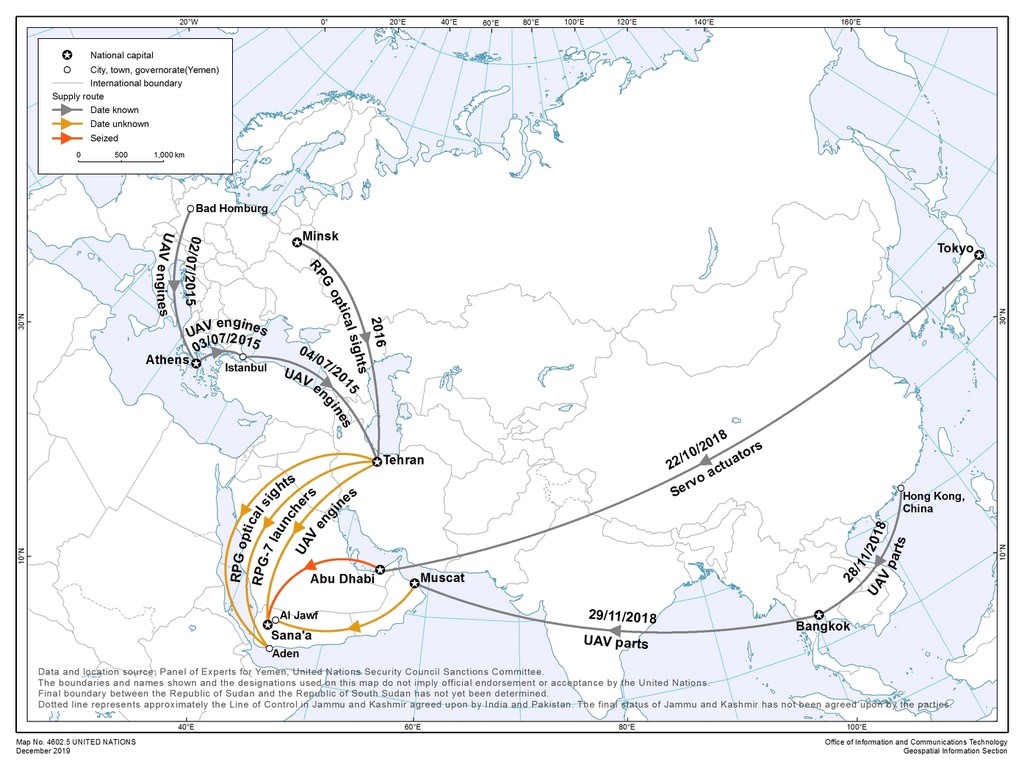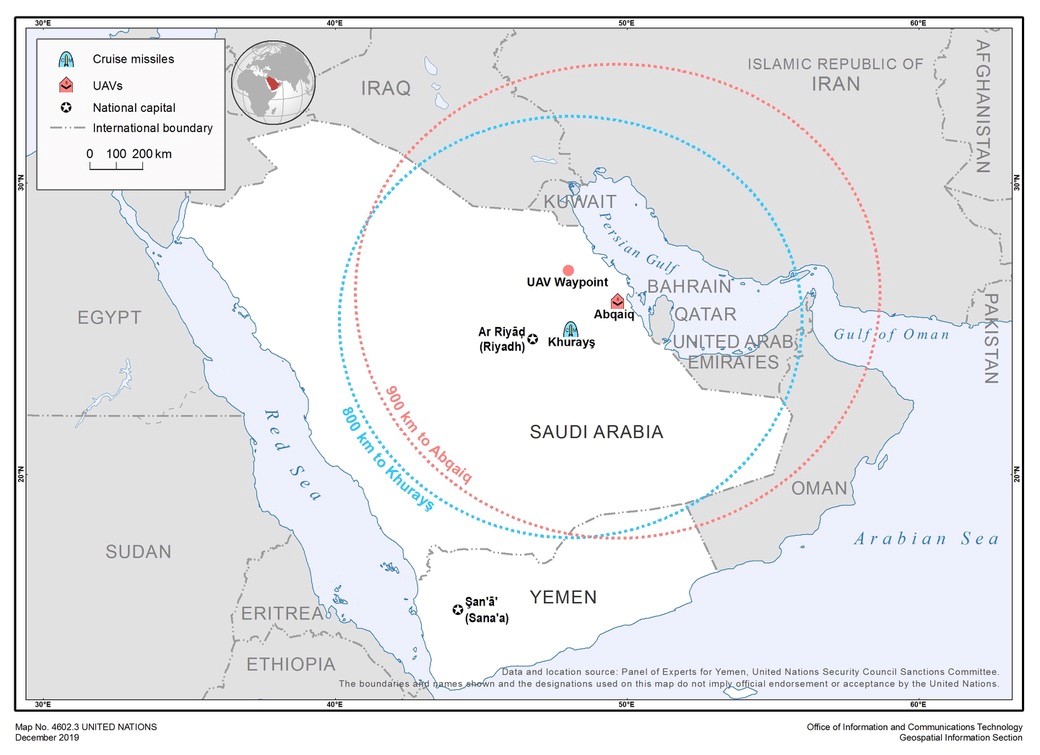Yemen’s Houthi rebels have used sophisticated weapons similar to those manufactured in Iran, according to a new report by the U.N. Panel of Experts on Yemen. Some weapons, including a new type of drone and a new model of cruise missile, had not been seen in Yemen before 2019. The Houthi rebels are members of a Zaydi Shiite movement that has been fighting Yemen’s Sunni-majority government since 2004. The Houthis took over the capital Sanaa in 2014 and seized control over much of north Yemen by 2016.
The U.N. report cited a weapons shipment seized off Yemen’s coast by the U.S. Navy on November 25 that included a Quds-1 cruise missile, a C802 anti-ship missile and surface-to-air missiles (SAMs). Brian Hook, the U.S. special envoy for Iran, said that the weapons were of “Iranian origin” during a press conference on December 5. The United States and Sunni Gulf states have alleged that Iran and its proxy Hezbollah have provided arms, training, and financial support to the Houthis. But Iranian and Hezbollah officials have denied or downplayed the claims.

The panel also concluded that the September 2019 attacks on Saudi Aramco oil facilities could not have originated in Yemen. Houthi rebels had claimed responsibility for the twin drone strikes. “The Panel has investigated the high-profile attack on 14 September 2019 on the Saudi Aramco facilities in Abqaiq and Khurays and finds that, despite claims to the contrary, the Houthi forces are unlikely to be responsible for the attack, as the estimated range of the weapon systems used does not allow for a launch from Houthi-controlled territory,” the experts said. But the report stopped short of blaming Iran for the attacks, which temporarily cut Saudi oil production in half.

The following is an excerpt from the U.N. report.
Final report of the Panel of Experts on Yemen
Summary
After more than five years of conflict, the humanitarian crisis in Yemen continues. The country’s many conflicts are interconnected and can no longer be separated by clear divisions between external and internal actors and events. Throughout 2019, the Houthis and the Government of Yemen made little headway towards either a political settlement or a conclusive military victory. In a continuation from 2018, the belligerents continued to practice economic warfare: using economic obstruction and financial tools as weapons to starve opponents of funds or materials. Profiteering from the conflict is endemic.
In the south, the Government of Yemen confronted the military challenges posed by the forces affiliated with the southern transitional council. The vice-president of the council, Hani Ali Salem Binbrek, initiated a conflict when he used force to remove what little authority the Government of Yemen held in Aden. Ongoing clashes on the Abyan and Shabwah borders and the limited progress in the implementation of the Riyadh Agreement indicate that the situation in the south remains volatile.
In the north, the Houthis continued to consolidate their political and military control, in particular through their pervasive intelligence services, which include both the preventative security and a new security and intelligence bureau. Houthi forces also engaged in the brutal suppression of tribal opposition and political dissent. The Panel of Experts on Yemen has identified a Houthi network involved in the repression of women who oppose the Houthis, including through the use of sexual violence, headed by the director of the Sana’a-based criminal investigation department, Sultan Zabin.
Throughout most of 2019, the Houthi forces continued and intensified their aerial attacks on Saudi Arabia. In addition to the previously known weapon systems, they used a new type of Delta-design uncrewed aerial vehicle and a new model of land attack cruise missile. The Panel has investigated the high-profile attack on 14 September 2019 on the Saudi Aramco facilities in Abqaiq and Khurays and finds that, despite claims to the contrary, the Houthi forces are unlikely to be responsible for the attack, as the estimated range of the weapon systems used does not allow for a launch from Houthi-controlled territory. Nevertheless, a number of other attacks on Saudi Arabia can clearly be attributed to the Houthi forces.
Following the attack in September, the Houthis made a public offer to establish a ceasefire. The ceasefire has been broadly complied with. Both Saudi Arabia and the Houthis now publicly state that they are engaged in discussions, while the launching of longer-range uncrewed aerial vehicles and missile strikes by Houthi forces against Saudi Arabia has abated.
With regard to potential violations of the targeted arms embargo, the Panel observes two major trends: the first is the transfer of commercially available parts, such as uncrewed aerial vehicle engines, servo actuators and electronics, which are exported from industrialized countries through a network of intermediaries to the Houthi-controlled areas of Yemen, where they are integrated into locally assembled uncrewed aerial vehicles and waterborne improvised explosive devices; the second is the continued reception by Houthi forces of military support in the form of assault rifles, rocket-propelled grenade launchers, anti-tank guided missiles and more sophisticated cruise missile systems. Some of those weapons have technical characteristics similar to arms manufactured in the Islamic Republic of Iran. For both commercial parts and weapons, the main smuggling route seems to run overland from Oman and the southern coast of Yemen, through territory controlled by the Government of Yemen, towards Sana’a. The high-profile seizure on 25 November 2019 of a dhow carrying anti-tank guided missiles and other missile parts in the Arabian Sea indicates that, as in previous years, sea transport continues to play a role in potential violations of the targeted arms embargo.
The absence of the rule of law and oversight in Yemen allows for the illicit enrichment of a small number of predatory entrepreneurs, some of whom hold official posts in public institutions. Within this context, and with the lack of any accountability, national wealth and external aid are increasingly either diverted or lost owing to corrupt practices by officials of the Government of Yemen and the Houthis. As tools of economic warfare, the parties have created obstacles to block the financing of the importation of goods and caused delays for the vessels carrying them to Yemen.
The Panel found indications of illicit enrichment through the manipulation of foreign exchange rates by the Central Bank of Yemen in Aden. The Panel found that the Houthis were involved in cases of violations of asset freeze measures by allowing the diversion of frozen assets and public funds through false contracts for the benefit of individuals acting on behalf of Abdulmalik al-Houthi (YEi.004). Saleh Mesfer Alshaer, a Houthi general in charge of logistics, was also instrumental in the diversion of funds unlawfully appropriated from Houthi opponents.
Violations of international humanitarian law and international human rights law continued to be widely committed by all parties in Yemen with impunity. The air strikes conducted by the Coalition to Support Legitimacy in Yemen, led by Saudi Arabia, and the indiscriminate use of explosive ordnance, including landmines, by Houthi forces continue to disproportionately affect civilians and civilian infrastructures. Arbitrary arrest and detention, enforced disappearances, ill-treatment and the torture of detainees continue to be conducted by the Government of Yemen, Saudi Arabia, the Houthis and the forces affiliated with the United Arab Emirates. In Aden, the absence of the rule of law allows armed groups affiliated with the United Arab Emirates to conduct such violations and to operate outside the control of the Government of Yemen. Threats and acts of violence against humanitarians, as well as administrative hurdles to the delivery of assistance, are increasing in Houthi-controlled areas.
Click here for the full text of the report.
For more information on Yemen's Houthis see:
